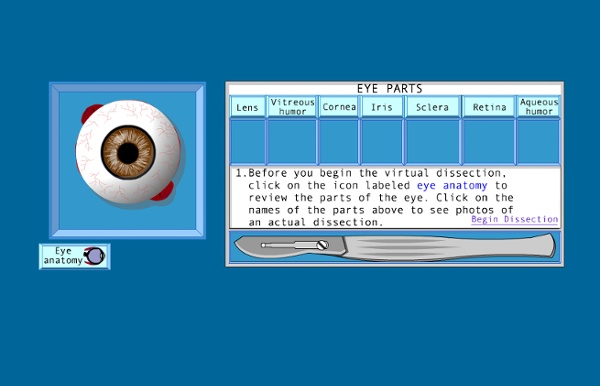



L'oeil et la vison Logiciel interactif et en 3D sur le thème de "L'oeil et la vision" destiné au programme SVT de 1ère L. Anatomie de l'oeil humain, œil entier et coupé en 3D. Imprime un document élève. Neuroscience For Kids you are here: home > explore Neuroscience For Kids explore table of contents The World of Neuroscience Brain Basics "Higher" Functions The Spinal Cord The Peripheral Nervous System The Autonomic Nervous System The Neuron Sensory Systems Neuroscience Methods and Techniques The Effects of Drugs on the Nervous System Neurological and Mental Disorders Copyright © 1996-2016, Eric H. home | search | explore | experiment | questions/answers | contact | links | donate newsletter | brain awareness week | Neuroscience in the News | poetry contest | books and articles | postcards | about | privacy | disclaimer | site map
Web site - Cloverbuds My National 4-H Congress Design Team Experience March 24, 2014 "I’ll never forget stepping off my plane in Atlanta for the second time and thinking, 'I get to experience this all again?' It seemed surreal, that I could be in another state, planning the National 4-H Congress, and be a member of the 2014 Design Team." ~ Critter Fink, 2014 National 4-H Congress Design Team Member 2014 4-H Wildlife & Forestry Day March 6, 2014 Come Learn About Pennsylvania's Forests and Wildlife! VMfitness Vive les SVT - Les sciences de la vie et de la terre au collège et au lycée - Découverte, actualité, cours, aide et soutien en ligne.
Touch Mathematics Chocolate Dipped Clementines ‘Tis the season for fun kitchen activities with the whole family. Looking for something fun to do with your little ones during the holiday break? Look no further than these scrumptious chocolate dipped clementines! Have your kids help peel, dip and decorate their way into a fun and healthy treat. 1. 2. 3. e-Cardiologie : toute la cardiologie expliquée et illustrée Southern In-Law: Recipe: Cheesy Baked Zucchini Boats Want to know something about me? I'm not normal. "That's not a nice thing to say about yourself" you say - but it's true. I have a serious problem with vegetables - and not in the way you might be thinking. What I'm trying to say is.... Baked Zucchini Parmesan Boats1 small/medium zucchini1 tbsp parmesan cheeseGarlic salt/seasonings, to tastePreheat your oven to 190°C/375°FWash and dry your zucchini.
Les maladies des yeux et les troubles de la vision de A à Z | Guide Vue --------------------------------------------------------------------------------------------------------------------------------------- A lire aussi Le schéma de l’œil et de ses organes : rétine, cristallin...Consulter un médecin ophtalmologisteOrdonnance valable 3 à 5 ans : à quelles conditions ? --------------------------------------------------------------------------------------------------------------------------------------- Les troubles de la vue peuvent être la conséquence de différentes causes : défaut visuel, anomalie de l'œil, pathologie oculaire, vieillissement naturel de l'œil... En France, ces troubles visuels touchent 68,4% de la population.* Il est important de ne pas faire d'amalgame entre les défauts visuels et les pathologies de l'œil. Les défauts visuels - myopie, hypermétropie et astigmatisme - sont considérés comme des imperfections géométriques de l'œil, ou des défauts de puissance de l'œil. Pour les autres pathologies oculaires, consultez le glossaire Plein écran
Finger KnittingHousing a Forest My kids Love learning new things, and they couldn’t wait to try their hand at finger knitting. I remember doing something similar when I was a kid, but we used a spool instead of our fingers. I was so excited when I came across every easy to follow video on how to finger knit (scroll to the bottom of the post for the video). Our recent trip to the cabin was the perfect time to teach the kids this simple skill. Plus I love that all that is needed for this project is a some yarn. No mess, no crazy supplies to remember, just a bit of yarn. Finger knitting is SO simple, that the kids picked it up right away. I love that the kids are fresh out of the shower, all snuggled by the fire knitting:) Before the weekend was over, we had piles of wonderful strands of finger knitting. Finger Knitted Jump Rope: The first project that we created with the kids knitting was a simple jump rope. Easy Finger Knitting Tutorial: For more Finger Knitting Projects, check out our: Finger Knitted Valentines Decor